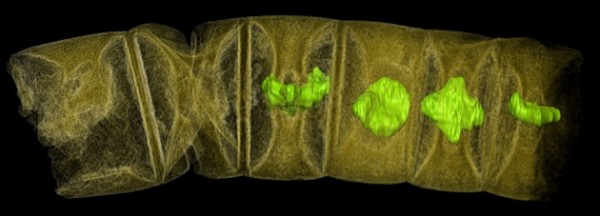By Ana Verayo, | March 15, 2017

A false-colour X-ray image of what could be the oldest-known fossil of a red algae. (Stefan Bengtson/Swedish Museum of Natural History )
Scientists have discovered some very ancient fossils containing a 1.6 billion years old red algae. In a new study, scientists suggest that this fossilized evidence could be the oldest plant in the world.
A team of researchers from the Swedish Museum of Natural History discovered these fossils embedded in sedimentary rock in Chitrakoot, Central India. Up until this discovery, the oldest known red algae was dated at 1.2 billion years old.
Like Us on Facebook
Scientists have debated about how complex life developed on Earth. However, larger, multicellular organisms thrived and became common some 600 million years ago. According to the lead author of the study, paleozoologist Stefan Bengtson from the Swedish Museum of Natural History, this discovery can also lead to the rewriting of the tree of life as the timeline of when visible life emerged on the planet now seems to have begun at a much earlier date than we previously thought.
This fossilized specimen is also very similar to red algae found within stromatolites, which are fossilized mats of cyanobacteria. This ancient cyanobacteria was uncovered in Indian phosphorite dating back to 1.6 billion years ago.
"We cannot confirm this ancient material's age since there is no DNA evidence remaining. However, the characters agree quite well to each other, specifically with the morphology and the overall red algae structure," Bengston explained.
During the study, scientists were able to use highly advanced, state-of-the-art tools like a synchotron-based X-ray tomographic microscope that can peer through sections and layers of a specimen. For this ancient algae, scientists were able to observe each cell's platelets and identified chloroplasts.
The team of researchers also discovered distinct structures within the core of each cellular wall which are common features seen in red algae. To date, the earliest traces of life on Earth appears in the form of single-celled organisms, dating back to 3.5 billion years.
This new study was published in the journal PLOS Biology.
-
Use of Coronavirus Pandemic Drones Raises Privacy Concerns: Drones Spread Fear, Local Officials Say

-
Coronavirus Hampers The Delivery Of Lockheed Martin F-35 Stealth Fighters For 2020

-
Instagram Speeds Up Plans to Add Account Memorialization Feature Due to COVID-19 Deaths

-
NASA: Perseverance Plans to Bring 'Mars Rock' to Earth in 2031

-
600 Dead And 3,000 In The Hospital as Iranians Believed Drinking High-Concentrations of Alcohol Can Cure The Coronavirus

-
600 Dead And 3,000 In The Hospital as Iranians Believed Drinking High-Concentrations of Alcohol Can Cure The Coronavirus

-
COVID-19: Doctors, Nurses Use Virtual Reality to Learn New Skills in Treating Coronavirus Patients







